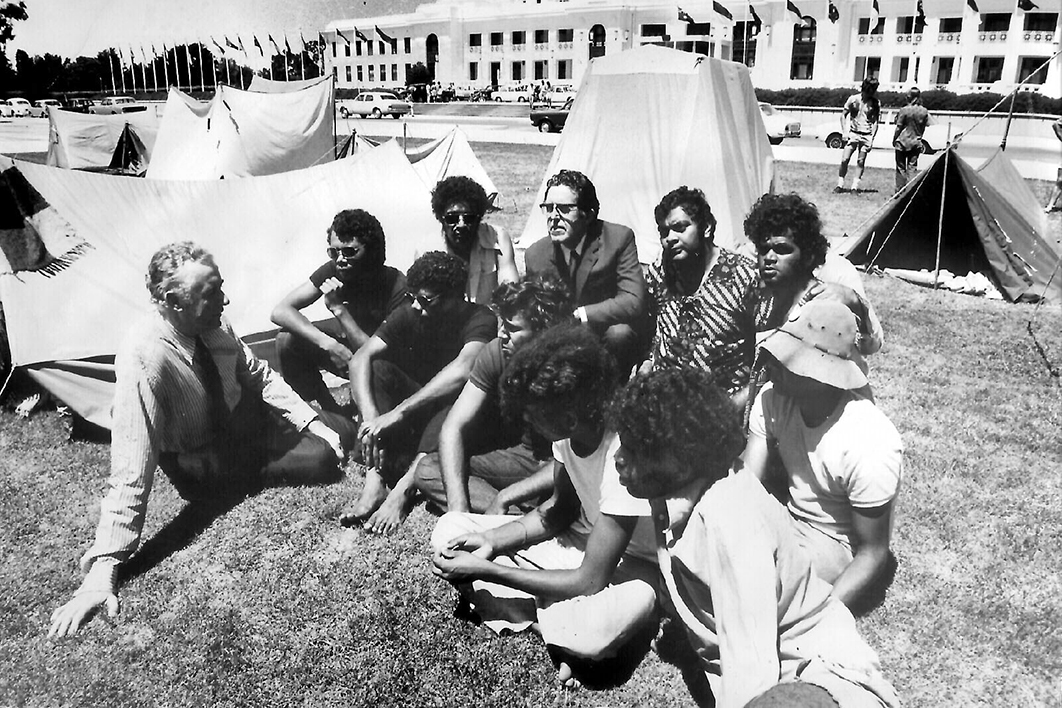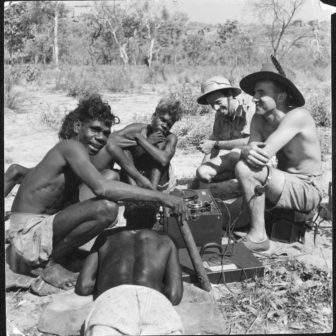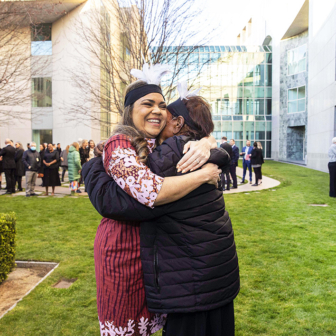One of the main objections to the proposed First Nations Voice is that its promise of Indigenous self-determination is a dead end. Some suspect that First Nations people, given the chance, will push for policies that are unwise. Others fear that the limited self-determination offered by the Voice is symbolism without substance.
These fears echo critiques already in the Australian ether. You might have heard that Indigenous self-determination policy failed. Or maybe you have doubts that it was ever properly tried — that Indigenous people were ever given a chance to manage their own affairs. Either way, self-determination might seem like an empty promise.
The term itself is associated with policies introduced by the Whitlam government in 1973. Under the banner of self-determination, Gough Whitlam held a royal commission into Aboriginal land rights, set up a federal Department of Aboriginal Affairs, affirmed First Nations cultures and funded Indigenous corporations. Whether this amounted to the hoped-for “self-determination” — in the eyes of First Nations people themselves, or of the United Nations for that matter — is debatable. Regardless, many scholars and activists consider the 1970s and 1980s a high point for self-determination in Australia.
After that, supposedly, things fell apart. In the decades that followed, governments’ commitment to the language and ideals of self-determination faltered and even withered away entirely. Persistent socioeconomic inequalities between Indigenous and non-Indigenous Australians in the early years of the twenty-first century convinced some thinkers that self-determination had failed.
For conservative critics, self-determination through national forms of Indigenous representation contradicted the ideal of the equality of citizens and divided the nation. In 2005, reflecting those views, the Howard government dismantled the Aboriginal and Torres Strait Islander Commission, which the Hawke government had set up to provide an elected national Indigenous structure of governance and representation. Then, two years later, it launched the Northern Territory Emergency Response, winding back many of the self-governing freedoms of remote communities while also boosting funding for Indigenous organisations on the ground.
Thinkers and activists on the left also argued that self-determination had failed, but for the opposite reason: true self-determination had never properly been attempted.
But we are not so convinced that self-determination, as either a policy framework or a political vision, was a failure. Although governments’ commitment to listening has at times waned, we’ve seen things improve when First Nations people have had a say on their own affairs.
One way First Nations people have done so is through their own organisations. The policy changes of the 1970s prepared the ground for the growth of an Indigenous organisational and institutional sector that now has a life of its own. Governments have certainly created the contexts that hinder or support Indigenous self-determination, but the self-determination genie is out of the bottle.
First Nations self-determination is not waiting for governments. The Indigenous community sector has been insisting on having a voice where policymakers would otherwise have forged ahead without their input. The long-term improvements in Indigenous wellbeing achieved by this sector reveal how much we might gain by creating a constitutionally enshrined Voice. First Nations people are asking governments to listen to their views, because that’s what works.
The Indigenous community-controlled sector is made up of an array of non-profit organisations based in Indigenous communities, governed by boards made up of Indigenous people and serving the interests of Indigenous people. Although Whitlam often gets the credit, this was not his invention. It began with the initiatives of First Nations people.
Aboriginal people in places like Redfern looked to the example of the Black Panther Party in the United States, which was running medical clinics and other urban survival programs for Black communities. The Aboriginal Legal Service opened a shopfront offering legal representation in Redfern in 1970 after activists began recording incidents of police violence. The Aboriginal Medical Service came the following year.
Then, in 1972, the Murawina preschool and childcare service opened as a breakfast program run out of the AMS, with Aboriginal women in full control from 1973. Around the same time, the Aboriginal Housing Company also began operating in inner Sydney. A group of these same community organisers from Redfern set up the Aboriginal Tent Embassy in early 1972. Legal academic Larissa Behrendt (a Eualeyai/Gamillaroi woman) has argued that the embassy’s commitment to building Aboriginal-controlled institutions — the AMS, the legal service, Aboriginal community-controlled childcare and the Black Theatre — was its enduring legacy.
As that timeline shows, the Whitlam government’s commitment to self-determination was a response to the calls of First Nations people. Just as the proposed Voice emerged as a First Nations idea, an earlier generation’s self-determination also began as an Indigenous project rather than a government agenda. The Black Theatre, established in 1972, actually announced Whitlam’s election win during the interval of its performance of Basically Black in December 1972.
Whitlam’s new Department of Aboriginal Affairs had an enormous budget, and Aboriginal organisations in Redfern and elsewhere suddenly received generous funding with minimal government oversight, at least initially. Even in the 1970s, though, the Indigenous sector’s vision diverged from official views. Governments were mostly interested in achieving socioeconomic parity with the non-Indigenous population, but the Indigenous sector understood itself as something more; it was to be a means of achieving self-determination.
Gary Foley (a Gumbainggir man), for instance, explained that the AMS considered itself “in the context of the political struggle because we’re simply an extension of that struggle, working… to ease the plight of the people we are politically working for.” Funding to the AMS and other organisations allowed Indigenous people to present their voice.
Two key bureaucrats in the Whitlam government, H.C. Coombs and Barrie Dexter, likewise intended Indigenous organisations to become a means by which First Nations people could voice and achieve their political aspirations (as these organisations had already been doing). In other words, they were to have a representative function. And this was considered appropriate: they were locally based and drew on existing partnerships and networks. For the Whitlam government, the blossoming sector was an organic expression of an Indigenous polity.
This community-controlled sector evolved over the decades from a tiny cluster of organisations powered by a few volunteers and minimal grants to a professionalised enterprise. In the 1970s, the institutional structures that could be used to express self-determination were limited: a handful of community-controlled services and a couple of land councils. Today, health remains the largest segment of the community-controlled sector, but it also extends to legal, education and family violence prevention services, along with Aboriginal statutory land rights and native title organisations, and Indigenous regional governance structures.
The organisations in this sector are mainly government-funded services, with governance drawn from communities. Although they are publicly funded, the fact that they draw money from various levels of government means they avoid being entirely dependent on any. Many are represented by the national peak body, the Coalition of Peaks.
Today, a growing, highly educated professional class exists within the Indigenous community. Numerous Indigenous parliamentarians have been elected across Australia. The community-controlled sector has enabled First Nations people to challenge institutions, forge pathways into universities, create culturally safe spaces in schools and workplaces, and take up ranks in the professions and academies.
Of course, the appalling inequities in health, incarceration rates and education reveal that much more needs to be done. Far from rendering the proposed Voice redundant, these successes give us a glimpse of what can be achieved when First Nations people are empowered to manage their own affairs.
While both ends of the political spectrum were decrying the death of self-determination in the early 2000s, a coalition of grassroots Indigenous and non-Indigenous organisations coalesced into a new campaign. They wanted to Close the Gap.
At first this was a community-driven movement promoted by people across the political spectrum searching for new policy consensuses in Indigenous affairs. Led by the Human Rights and Equal Opportunity Commission (renamed the Australian Human Rights Commission in 2008) and the Aboriginal and Torres Strait Islander social justice commissioner, Tom Calma (a Kungarakan/Iwaidja man), Close the Gap brought a human rights approach to questions of health equity. It campaigned for clear targets that would “close gaps” between Indigenous and non-Indigenous Australians.
As governments became more involved, though, the Indigenous organisational sector was shut out of the movement. In 2007 and 2008, the Council of Australian Governments settled a series of agreements, referred to as Closing the Gap, that included Indigenous policy targets for life expectancy, infant mortality, early childhood education in remote communities, reading, writing and numeracy, retention rates to year 12, and employment outcomes. They also included national partnership funding agreements negotiated among governments. The Indigenous organisations that had campaigned for this approach were consulted but had no seat at the negotiation table.
Each year since 2009 the prime minister has tabled an annual Closing the Gap Report (to which the Australian Human Rights Commission has responded annually with its counter reports, Close the Gap). The outcomes have been disappointing.
Self-determination, meanwhile, seemed to be at a low ebb. When the authors of the Uluru Statement called for a First Nations Voice to achieve “justice and self-determination” in May 2017, the Turnbull government immediately dismissed the proposal. Like other conservative governments, it was suspicious of national articulations of Indigenous self-determination through representation, preferring instead to work with local Indigenous organisations.
In the meantime, governments had begun developing a Closing the Gap Refresh, and in October 2018 a newly formed Coalition of Aboriginal Peak Organisations intervened in the Refresh process. Labelling this intervention an “act of self-determination,” the Coalition of Peaks wrote to the prime minister, premiers and chief ministers insisting that Indigenous communities must be represented in these negotiations. They wanted a voice.
At that stage, the Coalition of Peaks was an alliance of thirteen organisations across the health, legal, family violence prevention and land rights/native title sectors. (It now comprises more than fifty peak and member organisations.) Governments had consulted them individually in the processes for setting priorities and targets, but they had not been included in drafting policy documents or the Council of Australian Governments’ decision-making process. They now insisted that governments go beyond consultation to shared decision-making with “those representing Indigenous communities.”
Once it was accepted, Indigenous involvement produced a markedly different agreement. Alongside greater involvement of First Nations people in decision-making it led to greater transparency and accountability. The new National Agreement on Closing the Gap included a significantly stronger focus on Indigenous-led data and evaluation processes; strengthened structures to enable Aboriginal and Torres Strait Islander people to share decision-making authority with governments and so accelerate policy and place-based progress; a stronger and defined role for the Aboriginal community-controlled sector; and a clearer policy objective in the reform of government systems.
The Coalition of Peaks is particularly concerned about improving the quality of Indigenous access to, control of and use of data. It also ensures that independent First Nations–led reviews will be carried out following independent reviews by the Productivity Commission. The idea was to create a mechanism whereby governments could be held accountable to First Nations people. It wanted to flip older models of accountability upside down.
Of course, the Coalition of Peaks is imperfect and limited in its representation of Indigenous communities. Not all its member organisations agree on all policy priorities and targets, nor do its positions represent the full diversity of Indigenous political interests. Significantly, the Coalition of Peaks is not a democratically elected representative body and most of its member organisations remain dependent on government funding, which is determined in turn by the political cycle. Its capacity to challenge governments, therefore, is necessarily limited.
The proposed Voice, on which Australians will soon have their say, will not share these weaknesses. Enshrined in the Constitution, outside short-term political cycles, it will be freer to speak more clearly than the Coalition of Peaks ever could. Selected by First Nations communities, it will be even more accountable to the First Nations communities it will represent.
If even the imperfect Coalition of Peaks has achieved greater accountability for governments and empowered local Indigenous leaders to address local concerns, we think the Voice could achieve much more.
So, did self-determination ever fail? As Wiradjuri scholar Robynne Quiggin has argued, Indigenous Australia is self-determining and calls on governments to catch up with its agenda. “The most consistent call from Indigenous Australia since the abandonment of self-determination policy is — ‘listen to us,’” she says. “Consistent with the fact that we continue to be self-determining despite government policy, we say… ‘work with us so that we can set our own course.’”
When Whitlam heeded Indigenous calls for self-determination and identified the emerging Indigenous community-controlled sector central to achieving that vision, his government set in motion a form of self-determination that can’t be contained. Indeed, the Indigenous sector has been described as the defining legacy of Whitlam’s self-determination policy.
Since the 1970s, and through the energy, experiences and empowerment of the Indigenous sector, new generations of First Nations leaders have emerged across the community, academy, public sector and business world. The Indigenous professional class is booming, growing in size by some 75 per cent between 1996 and 2006 and gaining on the professionalisation of the general population.
First Nations people are exercising increasing control of their own affairs in the domains of land rights, health, education and environmental management through Indigenous organisations, as well as self-government through local Aboriginal councils. Building on experiences in this sector, First Nations people within government bureaucracies and peak bodies are also advancing Indigenous interests. These successes show us this is what works.
But the Closing the Gap Refresh experience also shows that, while governments might listen to Indigenous communities, these voices can also be overpowered and even silenced when bureaucratic systems take on a life of their own.
We don’t yet know what the long-term effects of the National Agreement will be, and there is much the Coalition of Peaks was unable to achieve. Nonetheless, First Nations people created an interim form of Indigenous representation at the highest levels while the constitutional discussion rolled on. This, we suggest, is a kind of self-determination, particularly in the absence of other more fully representative options such as the Voice.
Given these successes, a constitutionally enshrined Voice is the obvious next step for Indigenous self-determination. What remains to be seen is whether Australians will be willing to take it. •




